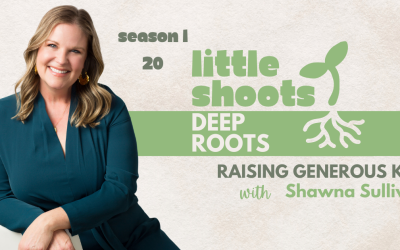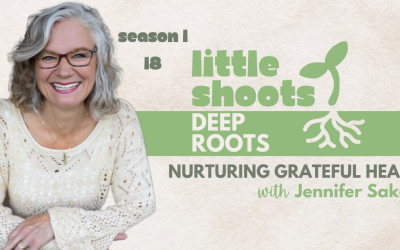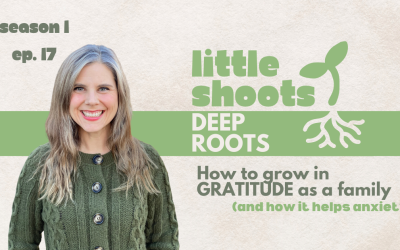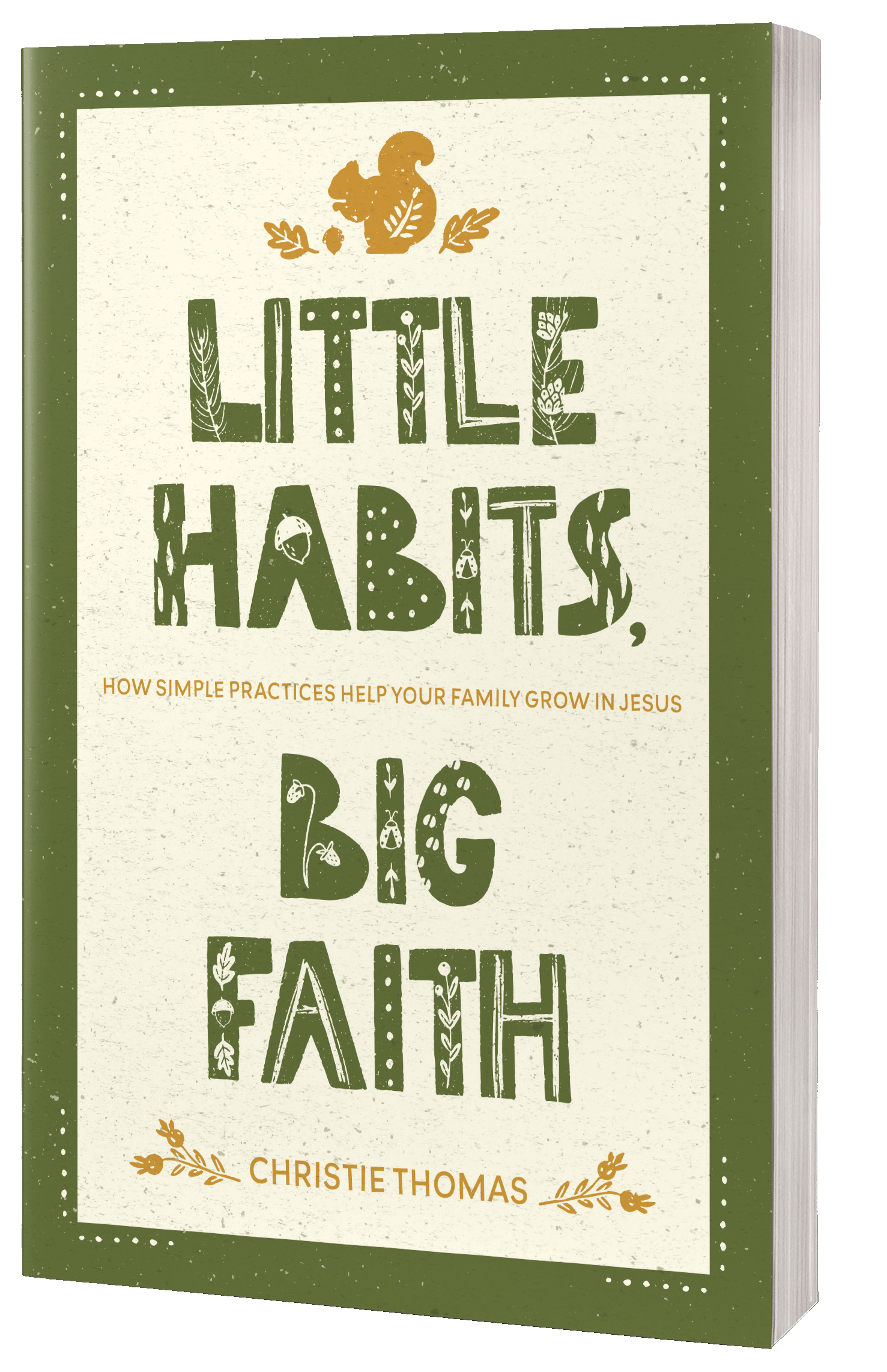Are you looking to raise kids who are generous, compassionate, and actively engaged in making a difference?
In today’s episode of Little Shoots Deep Roots, we dive into simple, practical strategies for creating a family culture of giving: not just with money, but with time and talents too.
I share personal stories about inspiring kids to take action, building empathy through storytelling, making giving tangible, and forming habits that stick, from Christmas donations to volunteering in the community. It all starts with one faithful nudge.
Ready to grow generosity at home? Let’s make giving a lifelong habit that transforms hearts and families.
📚 FOLLOW-UP RESOURCES
- FREE: The Start Little Guide
- BOOK: Little Habits, Big Faith: find the right habits for this moment in your family life
- CHILDREN’S BOOK: The Sparkle Box, by Jill Hardie
Subscribe on your favorite listening platform for practical tips, real parent interviews, and encouragement as we become faith gardeners together!
📝TRANSCRIPT
Have you ever watched your child give something away – whether time, a toy, or even a nickel – and realized you were seeing something holy? Today we’re talking about how we, as parents, can shape a family culture of giving. Not just spontaneous generosity, but a rhythm. A habit, or a heart that is tender toward others.
Welcome to Little Shoots, Deep Roots, where we become faith gardeners, cultivating deep faith in our families one little habit at a time. I’m your fellow gardener, Christie Thomas, and today we’re diving into the practice of giving…not just money, but our time, talents and treasure.
Giving is a discipleship practice, like prayer or reading the Bible. And just like those habits, it’s something that grows best when practiced together.
Our Time and Talents Story
“I’ll name it Creative Kids For Compassion,” my 9-year-old son announced at dinner.
This was the beginning of his big plan to raise funds that would help people gain access to clean water. That night, he sat down to finish writing a story, which he then proceeded to illustrate and type. His 6-year-old brother was inspired to write his own story, and Creative Kids For Compassion was born.
Over the next several months, the boys sold their books both online and in person. Twice they stood outside for hours on a freezing autumn day to sell their books and homemade trinkets at the farmer’s market, all so they could help provide clean water to those in extreme poverty. My youngest was 4 at the time, and I remember him standing in front of our booth at the farmer’s market, yelling “do you want to buy a book?”
In this example, the giving that kids did wasn’t my initiative—it was my child’s. I fanned the flame. My son surprised me with his idea, and I said “YES” to it, helping him bring it to life. And his little brothers joined in, showing that giving is contagious in families.
This was an example of giving of our time and talents…but what about treasure?
Our Treasure Story
About 10 years ago, the western world was reeling from the implications of the Syrian refugee crisis. Remember the dead children washing up on the shores of Greece? Awful stuff.
One Friday night, my young boys and I were reading about the life of Elisha and talked about how God had used him to help the widow. We discussed how God sometimes wants to use us to help others in need as well. I took this opportunity to share with my boys a little bit about the refugee crisis.
I told them that there are some countries in the world where “there are lot of bad guys. They are trying to hurt people and take their homes. These people want so badly to escape the bad guys that they run away from their homes. They don’t bring anything with them – clothes, food, money, or cars. They walk, and walk, and walk until they reach a place that is safer. But it is very hard for them to find a place that is safe.”
I proposed a plan – we would count and sort all our cans and bottles then bring them to the bottle depot. After we got our money we would use it to buy gift cards from Superstore. Our church already works with refugees and there was a family coming from Burma very soon, so the gift cards would go to them. After an initial hesitation (because they remembered the stench and noise of the bottle depot!) they agreed wholeheartedly.
I was so proud of them; they did not complain about not getting to keep any of the money, and they were so excited to pass their bills over to the cashier in exchange for the gift cards.
They may not have known much about the horror of being a refugee, but they did know that they can do something to help. Kids can grasp sacrificial giving when they know who it helps.
The smell of the bottle depot is burned into our family memory—but so is the joy of handing over those gift cards.
Last year, my kids were much older so the giving looked different. We turned on the radio, only to hear a full-day fundraiser for World Vision. When we heard the stories they were telling about the children in need of help, I asked my boys if they wanted to donate some money to the fundraiser. As soon as we got home, they all ran to their rooms to grab some money.
Every year we also love make some donations through the Christmas gift guide. When my boys were really little, I cut out the pictures and taped them to the wall. Each day we prayed about which one to take down, until, near the end of December, we had one left that we donated to. As my kids got older and had set aside some money for sharing, I invited them to contribute toward a group gift through one of the gift guides. And now, as they’re even older, I’ve given THEM the gift guides in November and asked them to pray about and choose something to save for. I don’t know, honestly, how much thought they’ll put into it, but my role is to keep offering opportunities to give of their treasure.
How to frame giving for your kids:
1) Tell stories that evoke empathy. If our kids never know what’s going on in the world, how can they serve? I’m not just talking about refugees, but also about needs in your own community. I heard of a family who serves at the food bank a couple Saturdays each month, which would be a great way to develop that empathy.
2) Make the action tangible. Have them count cans, carry boxes at the food bank, or hand out actual cash.
The Sparkle Box: Giving as Worship
If you’re looking for a good way to introduce the idea of giving as worship, I highly recommend a book called “The Sparkle Box”.
The Sparkle Box, written by Jill Hardie, is about a boy whose parents put a sparkly box under their Christmas tree. Naturally, he’s not allowed to know what’s in it until Christmas Day, although he’s very curious. Throughout the story, the boy and his parents serve others in very natural ways. He gives his mitts to a person who’s shivering on the street. They bring gifts to others and serve in other ways.
On Christmas Day, he opens the box and finds it full of pieces of paper. On each piece of paper is written something kind that he did for someone else that season. His parents explain that the Sparkle Box is actually a gift for Jesus, not for him. And the gift is all the ways that he has served others.
I read The Sparkle Box to our church congregation one year at our Christmas Day service. The book actually comes with a real sparkle box, and over December I had asked parents to tell me what kind deeds their children were doing. After reading the story to the congregation, I was able to share the contents of our own Sparkle Box with the crowd, and it was so powerful.
From Inspiration to Habits: Making Giving a Rhythm
So how do we help our kids move from one-time inspiration to long-term formation? In our family, we’ve found that giving is more likely to become a habit when it’s rhythmic. I’m going to offer some habit ideas for giving of time, talents, and treasure, not just money.
- Regular habits:
- Treasure: Setting aside 10% from allowance or odd jobs.
- Time/talents: At my friends’ house the other day, her teenage son was about to leave and asked her “is there anything you need me to do before I leave?” I was floored! She told me she’d been teaching that to them since they were very young, and her husband is also a great example of asking that questions.
- Seasonal habits:
- Treasure: Choosing from gift catalogues around Christmas (and maybe letting them stay up late to do it!). If you don’t have treasure for this, consider fundraising instead!
- Time/Talents: One thing our family does is say “yes” when our church asks for help with an event, like the Canada Day carnival or a Christmas dinner.
The goal isn’t to do everything—but to do something, again and again, until giving becomes a part of who they are.
As they’ve grown we’ve done things like pass out the candles during our church’s Christmas Eve service and set up for events. When they were little I’d watched my friends’ kids while she went to a doctor’s appointments. Small kids can participate in that. If you do something like help with the meals ministry at church, little kids can go with you to deliver meals, bigger kids can help cook them, and older teens can actually drop the meals off.
Kids of any age can participate in giving gifts to your neighbors. One time we baked cookies specifically for our elderly neighbour who had been in the hospital. This sweet woman told us that we were the best neighbours she had ever had.
I’ve also brought my kids to help at the food bank, although that was tricky because there wasn’t much they could do except fold boxes! Through our homeschool coop we also sometimes visit a retirement home and play games with the folks there. We’ve also put together homeless bags for people we meet or drive past who are asking for money.
You don’t have to raise a mini philanthropist overnight. Start small. Tell a story. Invite your kids to dream…or sort some bottles. The holy habit of giving begins not with grand gestures, but with faithful nudges.
What’s one small step you can take toward building a generous spirit in your family?
Maybe this week you set aside 10% of your child’s allowance. Or maybe you pick up the Sparkle Box book and use it to guide your Christmas season. Or maybe…you just tell a story that invites your kids into compassion.
Coming Up Next
In the next episode, I’ll be talking with Shawna Sullivan about how giving and stewardship look in their home! I’ll hope you’ll tune in for that episode as well.
Closing Blessing
Let me pray a blessing over you. If you’re able, hold out your hands to receive it:
May your home be filled with generosity: not just in what you give, but in how you give it: joyfully, faithfully, together. In Jesus’ name, amen.
Thanks for joining me here at Little Shoots, Deep Roots. If you’ve enjoyed this podcast, I’d love if you’d take a minute to leave a review. And please download the Start Little Guide in the show notes to help you discover how to start and maintain sustainable faith habits (like giving) in your family.
Growing with you,
Christie









0 Comments